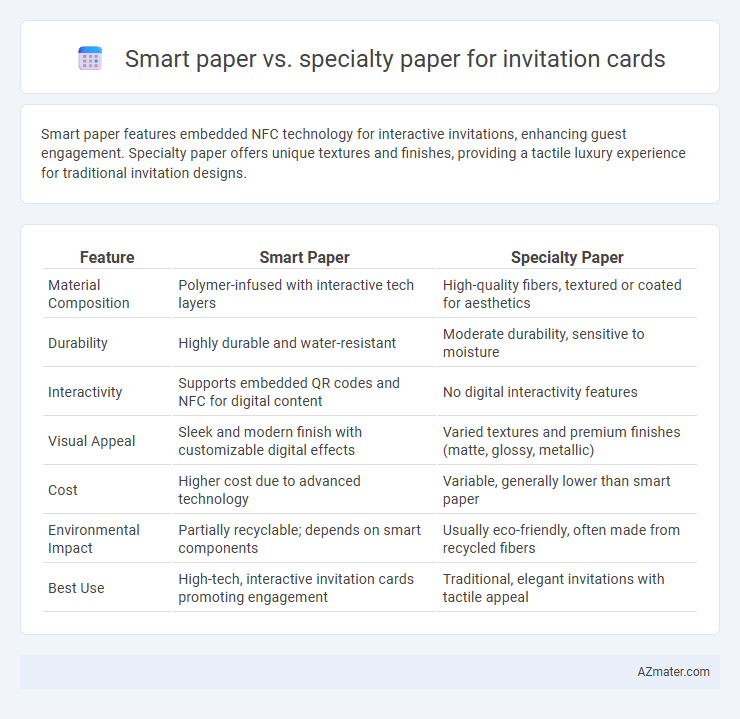Smart paper features embedded NFC technology for interactive invitations, enhancing guest engagement. Specialty paper offers unique textures and finishes, providing a tactile luxury experience for traditional invitation designs.
Table of Comparison
| Feature | Smart Paper | Specialty Paper |
|---|---|---|
| Material Composition | Polymer-infused with interactive tech layers | High-quality fibers, textured or coated for aesthetics |
| Durability | Highly durable and water-resistant | Moderate durability, sensitive to moisture |
| Interactivity | Supports embedded QR codes and NFC for digital content | No digital interactivity features |
| Visual Appeal | Sleek and modern finish with customizable digital effects | Varied textures and premium finishes (matte, glossy, metallic) |
| Cost | Higher cost due to advanced technology | Variable, generally lower than smart paper |
| Environmental Impact | Partially recyclable; depends on smart components | Usually eco-friendly, often made from recycled fibers |
| Best Use | High-tech, interactive invitation cards promoting engagement | Traditional, elegant invitations with tactile appeal |
Introduction to Smart Paper and Specialty Paper
Smart paper for invitation cards incorporates embedded technology such as NFC or QR codes, enabling interactive digital features and enhanced personalization. Specialty paper, including textured, metallic, or handmade options, emphasizes unique tactile qualities and aesthetic effects that elevate the invitation's visual appeal. Both types offer distinct advantages: smart paper enhances functionality while specialty paper focuses on artistic and sensory impact.
What is Smart Paper?
Smart Paper is a high-tech, interactive paper embedded with digital technology such as NFC chips or QR codes, enabling seamless connectivity and enhanced user engagement for invitation cards. This innovative paper allows recipients to access multimedia content, RSVP forms, or event details directly through their smartphones, offering a dynamic experience beyond traditional physical invitations. Compared to specialty paper, which emphasizes texture and finish, Smart Paper integrates digital functionality to modernize and personalize invitation cards efficiently.
What Defines Specialty Paper?
Specialty paper for invitation cards is defined by its unique textures, finishes, and weight that enhance visual appeal and tactile experience. Unlike smart paper, which incorporates interactive or digital features, specialty paper emphasizes premium materials such as cotton, vellum, or metallic finishes designed to convey elegance and sophistication. These distinctive characteristics make specialty paper ideal for creating memorable and high-quality invitations.
Key Features of Smart Paper
Smart paper for invitation cards features embedded microchips that enable dynamic customization, allowing recipients to interact with digital content through NFC connectivity. This innovative technology enhances user engagement by integrating multimedia elements seamlessly into physical invitations, offering personalization beyond traditional print. Smart paper also boasts durability and eco-friendly materials, setting it apart from specialty papers that mainly focus on unique textures and finishes.
Unique Qualities of Specialty Paper
Specialty paper for invitation cards offers unique qualities such as enhanced texture, vibrant color retention, and superior durability that elevate the overall aesthetic and tactile experience. Unlike smart paper, which often integrates digital features or interactive elements, specialty paper emphasizes artisanal finishes like embossing, foil stamping, and handmade fibers. These characteristics make specialty paper ideal for creating memorable, high-end invitations that convey sophistication and exclusivity.
Design Flexibility: Smart vs Specialty Paper
Smart paper offers exceptional design flexibility for invitation cards, allowing for vibrant colors, intricate patterns, and customizable textures that enhance visual appeal. Specialty paper, while often providing unique tactile qualities and finishes like embossed surfaces or metallic sheens, may limit design options due to its specific material properties. Choosing between smart and specialty paper depends on the desired balance between innovative design versatility and distinctive, high-end paper characteristics.
Print Quality and Finish Comparison
Smart paper offers high print quality with sharp, vibrant colors and excellent resolution, making it ideal for detailed invitation card designs. Specialty paper provides unique textures and finishes such as matte, glossy, or embossed effects that enhance the tactile appeal and luxury feel of invitation cards. While smart paper excels in clarity and color accuracy, specialty paper specializes in premium finishes that elevate the overall aesthetic and user experience.
Cost Differences: Smart vs Specialty Paper
Smart paper for invitation cards typically costs less than specialty paper due to its standard production methods and materials, making it a budget-friendly option for bulk orders. Specialty paper involves unique textures, finishes, or handcrafted elements that significantly increase its price. Choosing between smart and specialty paper depends on balancing cost-effectiveness with the desired visual and tactile impact for the invitation.
Eco-Friendliness and Sustainability
Smart paper for invitation cards often integrates recyclable materials and low-energy production processes, boosting eco-friendliness by reducing carbon footprints. Specialty paper, while offering unique textures and finishes, may involve higher environmental costs due to chemical treatments and less sustainable sourcing. Choosing smart paper supports sustainable practices through biodegradability and reduced waste, aligning with green event planning goals.
Choosing the Best Paper for Your Invitation Cards
Smart paper offers enhanced print clarity and moisture resistance, making it ideal for vibrant, durable invitation cards that impress with sharp images and text. Specialty paper, including textured or metallic finishes, provides unique tactile and visual appeal, perfect for luxurious or themed invitations that demand a distinct look. Select smart paper for cost-effective, high-quality prints, while specialty paper suits occasions needing a premium, customized touch.

Infographic: Smart paper vs Specialty paper for Invitation card
 azmater.com
azmater.com